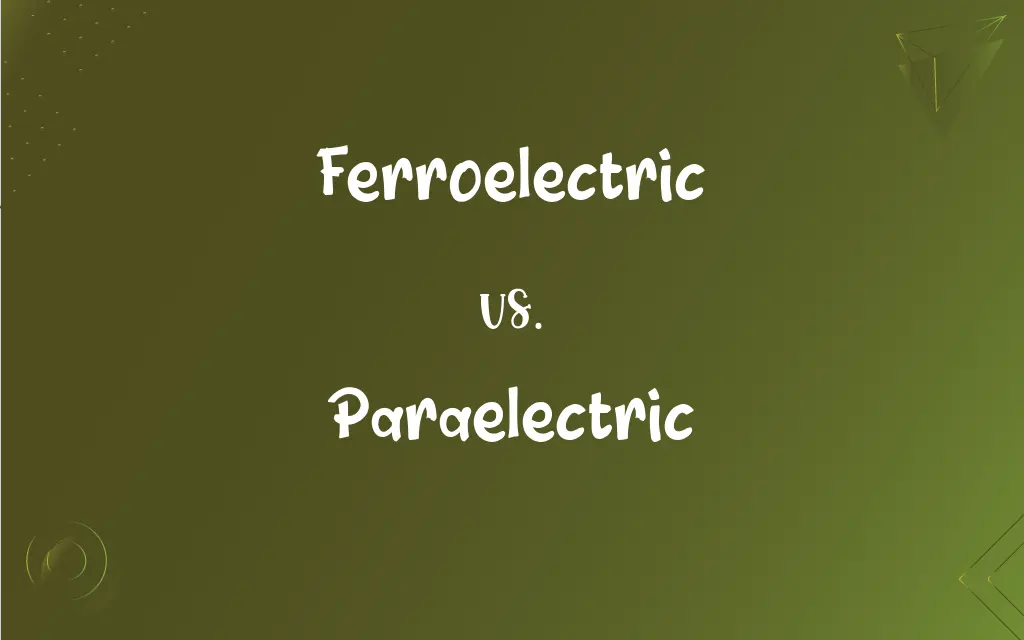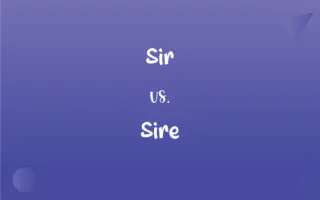Ferroelectric vs. Paraelectric: What's the Difference?
By Janet White & Aimie Carlson || Updated on May 21, 2024
Ferroelectric materials have a spontaneous electric polarization that can be reversed by an external electric field, whereas paraelectric materials do not have spontaneous polarization and only polarize in response to an external electric field.

Key Differences
Ferroelectric materials exhibit spontaneous electric polarization, which means they have a built-in electric dipole moment even in the absence of an external electric field. Paraelectric materials, on the other hand, do not have any inherent electric dipole moment without an external electric field.
Ferroelectric materials exhibit a hysteresis loop in their polarization vs. electric field graph, indicating their ability to retain polarization states. This property is crucial for non-volatile memory applications. Paraelectric materials lack this hysteresis behavior. Their polarization increases linearly with the applied electric field, and they do not retain any polarization after the external field is removed, which limits their use in memory storage but allows for other applications like capacitors.
The temperature dependence of ferroelectric materials is significant; they exhibit ferroelectricity below a certain temperature called the Curie temperature. Above this temperature, they transition to a paraelectric state. Paraelectric materials are always in the paraelectric state regardless of temperature changes. They do not exhibit a transition to a ferroelectric state, which simplifies their use in devices that operate over a wide range of temperatures.
Ferroelectric materials are typically found in specific crystal structures that allow spontaneous polarization, such as perovskites. Paraelectric materials, on the other hand, do not require such specific crystal structures and can be found in a broader range of materials.
Comparison Chart
Spontaneous Polarization
Present
Absent
ADVERTISEMENT
Response to Electric Field
Reversible polarization
Polarizes only with applied field
Hysteresis Behavior
Exhibits hysteresis loop
No hysteresis
Temperature Dependence
Ferroelectric below Curie temperature
Always paraelectric
Crystal Structure
Specific structures like perovskites
Varied structures
Ferroelectric and Paraelectric Definitions
Ferroelectric
Having a natural electric dipole moment.
Ferroelectric materials are used in memory devices due to their spontaneous polarization.
ADVERTISEMENT
Paraelectric
Lacks inherent electric dipole moment without an external field.
Paraelectric materials do not have a natural polarization.
Ferroelectric
Shows the relationship between polarization and electric field.
The hysteresis loop of a ferroelectric material is essential for its use in non-volatile memory.
Paraelectric
Polarizes only when an external electric field is applied.
Applying an electric field induces polarization in paraelectric materials.
Ferroelectric
Requires a certain crystal arrangement to exhibit properties.
Perovskite structures are common in ferroelectric materials.
Paraelectric
Polarization increases linearly with the applied field.
Paraelectric materials exhibit linear polarization with increasing electric field.
Ferroelectric
The temperature below which a material is ferroelectric.
Ferroelectric materials lose their properties above the Curie temperature.
Paraelectric
Does not retain polarization after removing the electric field.
Unlike ferroelectric materials, paraelectric materials do not have hysteresis loops.
Ferroelectric
Polarization can be reversed by an external electric field.
Applying an electric field can switch the polarization direction in ferroelectric materials.
Paraelectric
Found in a broad range of crystal arrangements.
Paraelectric materials can have various crystal structures.
Ferroelectric
Of or relating to a crystalline dielectric that can be given a permanent electric polarization by application of an electric field.
Paraelectric
Of, pertaining to, or exhibiting paraelectricity
Ferroelectric
A ferroelectric substance.
Ferroelectric
(physics) of, or relating to the permanent electrical polarization of a crystalline dielectric in an electric field
Ferroelectric
A ferroelectric material
FAQs
What is a paraelectric material?
Paraelectric materials do not have spontaneous polarization and only polarize in response to an external electric field.
How does the polarization behavior differ between ferroelectric and paraelectric materials?
Ferroelectric materials retain polarization states (hysteresis), while paraelectric materials polarize only with an external field and do not retain it.
What is the Curie temperature in ferroelectric materials?
The Curie temperature is the temperature below which ferroelectric materials exhibit spontaneous polarization.
Can ferroelectric materials be used in memory devices?
Yes, due to their reversible polarization and hysteresis properties.
What is a ferroelectric material?
Ferroelectric materials have a spontaneous polarization that can be reversed by an external electric field.
What kind of hysteresis behavior is seen in ferroelectric materials?
Ferroelectric materials show a hysteresis loop in their polarization vs. electric field graph.
Do paraelectric materials exhibit a Curie temperature?
No, paraelectric materials do not exhibit a transition and remain paraelectric at all temperatures.
Do paraelectric materials have a hysteresis loop?
No, paraelectric materials do not exhibit hysteresis loops.
Can ferroelectric properties be induced in any material?
No, only materials with specific crystal structures can exhibit ferroelectric properties.
Are paraelectric materials used in memory devices?
Generally, no, because they do not retain polarization states.
What happens to ferroelectric materials above their Curie temperature?
They transition to a paraelectric state.
What type of crystal structures do ferroelectric materials usually have?
Ferroelectric materials often have specific structures like perovskites.
Do paraelectric materials require specific crystal structures?
No, they can be found in a broader range of structures.
How does temperature affect ferroelectric materials?
Ferroelectric materials lose their properties above the Curie temperature.
What is a common application for paraelectric materials?
Paraelectric materials are commonly used in capacitors due to their ability to polarize under an electric field.
Does temperature affect paraelectric materials the same way?
No, paraelectric materials do not have a Curie temperature and remain paraelectric regardless of temperature.
Are paraelectric materials used in capacitors?
Yes, because they can polarize under an electric field, making them suitable for capacitors.
Can paraelectric materials transition to a ferroelectric state?
No, they remain paraelectric across all temperatures.
What applications benefit from the hysteresis properties of ferroelectric materials?
Non-volatile memory devices and sensors benefit from these properties.
Do paraelectric materials have non-volatile memory applications?
Typically, no, due to their lack of hysteresis and retention.
About Author
Written by
Janet WhiteJanet White has been an esteemed writer and blogger for Difference Wiki. Holding a Master's degree in Science and Medical Journalism from the prestigious Boston University, she has consistently demonstrated her expertise and passion for her field. When she's not immersed in her work, Janet relishes her time exercising, delving into a good book, and cherishing moments with friends and family.
Co-written by
Aimie CarlsonAimie Carlson, holding a master's degree in English literature, is a fervent English language enthusiast. She lends her writing talents to Difference Wiki, a prominent website that specializes in comparisons, offering readers insightful analyses that both captivate and inform.































































